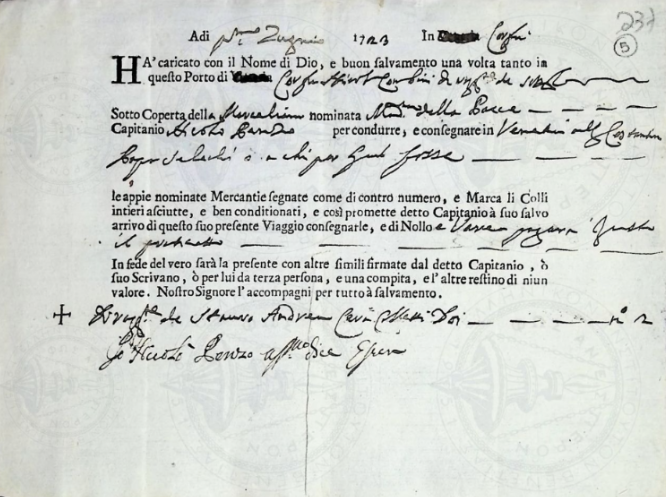Trade Activity


The Galinotati based its economy on trade. In the late 15th and early 16th centuries, however, many of Venice's private banks went bankrupt because the young patricians abandoned the maritime life and turned to exploiting the Italian hinterland as landowners. As a result, the Venetian economy became more closely linked to foreign merchants, which strengthened the ties with the Greek element. It is estimated that in the 16th century, 15-20 ships from the Greek regions of the East sailed into the port of Venice.
A great deal of information is available from commercial manuals printed in Venice, while a characteristic feature of commercial activity was its organisation - most of the time - on the basis of 'companionship' or 'compania'. The latter was made up of the main shareholders and was supported by a network of agents who contacted the producers in order to supply mainly agricultural products from the region or vice versa, with a view to selling western craft products on the domestic market.
The Greek merchants from the Venetian-occupied areas, who traded with Venice, were aware of the practice of the insurance contract from the end of the 16th century, as evidenced by the cargo and ship insurance policies in the old archives of the Brotherhood.
The merchants worked with various producers and other merchants in different regions, both inside and outside Venice. For example, they worked with agricultural producers to supply goods such as grain and oil, while trading in western crafts such as textiles and leather from other European countries. This cooperation with foreign trading companies and producers shows the multidimensional and transnational nature of their commercial activities.
The book was also a marketable product, which was subject to the general trade of the time, mainly in relation to the demand that existed. Merchants supplied books for which they most often had a buyer ready.
Among the important Greek merchants of the Brotherhood who accumulated capital and acquired property in Venice were the families of the Kouβλήis and Samariaris, as well as the shipowner Andreas Kourkoumelis, who also cooperated with foreign trading companies.
Numerous items relate to merchants and trade relations with Egypt, Spain, other Italian ports and Tunisia. In the late 17th century Greek merchants appear to have joined the Venetian collective professional bodies and in the 18th century, according to evidence, Greek merchant enterprises numbered around 45. Some of them acquired such economic standing that they were placed in the upper echelons of local society. They managed to integrate quickly, while retaining their identity intact. Their presence leaves its mark on Venetian life, science, literature and architecture.
The presence of the sailor-merchants in the affairs of the Brotherhood was important, as they contributed generously to its financial support and participated actively in its administration. These merchant-sailors combined the knowledge and skills of trade with the experience of navigation, creating a dynamic professional sector that enhanced the economic and social presence of the Greeks in Venice.
These merchant-sailors combined the knowledge and skills of trade with the experience of navigation, creating a dynamic professional sector that strengthened the economic and social presence of the Greeks in Venice.
The flourishing of the Greek community, which chose as its patron Saint Nicholas the Sailor, was directly linked to trade and navigation, but due to the existing political situation in the 19th century, the Greeks left Venice and chose other places of settlement and action..

